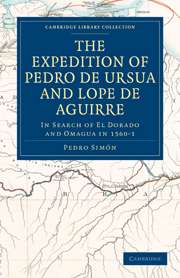 The Expedition of Pedro de Ursua and Lope de Aguirre in Search of El Dorado and Omagua in 1560–1
The Expedition of Pedro de Ursua and Lope de Aguirre in Search of El Dorado and Omagua in 1560–1 Book contents
- Frontmatter
- Contents
- INTRODUCTION
- CHAPTER I
- CHAPTER II
- CHAPTER III
- CHAPTER IV
- CHAPTER V
- CHAPTER VI
- CHAPTER VII
- CHAPTER VIII
- CHAPTER IX
- CHAPTER X
- CHAPTER XI
- CHAPTER XII
- CHAPTER XIII
- CHAPTER XIV
- CHAPTER XV
- CHAPTER XVI
- CHAPTER XVII
- CHAPTER XVIII
- CHAPTER XIX
- CHAPTER XX
- CHAPTER XXI
- CHAPTER XXII
- CHAPTER XXIII
- CHAPTER XXIV
- CHAPTER XXV
- CHAPTER XXVI
- CHAPTER XXVII
- CHAPTER XXVIII
- CHAPTER XXIX
- CHAPTER XXX
- CHAPTER XXXI
- CHAPTER XXXII
- CHAPTER XXXIII
- CHAPTER XXXIV
- CHAPTER XXXV
- CHAPTER XXXVI
- CHAPTER XXXVII
- CHAPTER XXXVIII
- CHAPTER XXXIX
- CHAPTER XL
- CHAPTER XLI
- CHAPTER XLII
- CHAPTER XLIII
- CHAPTER XLIV
- CHAPTER XLV
- CHAPTER XLVI
- CHAPTER XLVII
- CHAPTER XLVIII
- CHAPTER XLIX
- CHAPTER L
- CHAPTER LI
- CHAPTER LII
CHAPTER XXVI
Published online by Cambridge University Press: 05 November 2011
- Frontmatter
- Contents
- INTRODUCTION
- CHAPTER I
- CHAPTER II
- CHAPTER III
- CHAPTER IV
- CHAPTER V
- CHAPTER VI
- CHAPTER VII
- CHAPTER VIII
- CHAPTER IX
- CHAPTER X
- CHAPTER XI
- CHAPTER XII
- CHAPTER XIII
- CHAPTER XIV
- CHAPTER XV
- CHAPTER XVI
- CHAPTER XVII
- CHAPTER XVIII
- CHAPTER XIX
- CHAPTER XX
- CHAPTER XXI
- CHAPTER XXII
- CHAPTER XXIII
- CHAPTER XXIV
- CHAPTER XXV
- CHAPTER XXVI
- CHAPTER XXVII
- CHAPTER XXVIII
- CHAPTER XXIX
- CHAPTER XXX
- CHAPTER XXXI
- CHAPTER XXXII
- CHAPTER XXXIII
- CHAPTER XXXIV
- CHAPTER XXXV
- CHAPTER XXXVI
- CHAPTER XXXVII
- CHAPTER XXXVIII
- CHAPTER XXXIX
- CHAPTER XL
- CHAPTER XLI
- CHAPTER XLII
- CHAPTER XLIII
- CHAPTER XLIV
- CHAPTER XLV
- CHAPTER XLVI
- CHAPTER XLVII
- CHAPTER XLVIII
- CHAPTER XLIX
- CHAPTER L
- CHAPTER LI
- CHAPTER LII
Summary
Previous to the voyage of the Maranoñes down this river, its first navigator was Captain Francisco de Orellana, who came from the river Canela (which, as we have said, rises in the provinces at the back of Quito). Orellana having met, during his voyage, with women of fair stature, who defended themselves from him and his soldiers, and opposed his advance, he gave them the name of Amazons, because they were like similar women of Scythia, who lived on the banks of the great river Tanais, whence they first moved to another river called Thermodon, and conquered by their arms the greater portion of Asia. These Amazons had the great Penthesilea for their queen and commander, and they are mentioned by Zachary Lilio, who says that they burnt the right breast off, that it might not hinder them in the management of arms, for the chase, or in war. Orellana had some reason for calling the women he met with Amazons, on account of their having fought against the Spaniards; yet in many provinces of these Indies, women have done the same: nor do we see why this river should be called the Amazons only on account of this occurrence. The most prevalent custom is to call it Marañon, as before stated. Its magnitude is such as to entitle it to the name of the gulf of sweet water, for, independent of its great size at its mouth, it, at times, when it rises, covers a hundred leagues of land with so much water that canoes and piraguas sail over the inundated land.
- Type
- Chapter
- Information
- The Expedition of Pedro de Ursua and Lope de Aguirre in Search of El Dorado and Omagua in 1560–1Translated from Fray Pedro Simon's Sixth Historical Notice of the Conquest of Tierra Firme by William Bollaert, pp. 107 - 113Publisher: Cambridge University PressPrint publication year: 2010First published in: 1861
